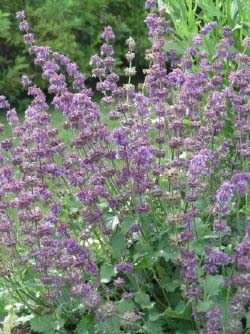Salvia Soothes Eye, Heart and Honeybees in Remembrance Gardens

Planting and nurturing gardens are acts of hope, faith, perseverance, and remembrance and, in some cases, of healing.In the days following the terrorist destruction of New York's World Trade Center on September 11, 2001, one article in The New York Times focused on the recovery of 30 acres of gardens of the Battery Park City Parks Conservancy a few blocks south of where the Twin Towers once stood.
Miracle Salvia in the Gardens
Wearing heavy rubber gloves and respirators, park workers rescued the gardens along the Hudson River from ashy debris that was 12 inches deep in some locations. As reporter Ann Raver noted, "[I]t seemed like a bit of a miracle to see the blue Salvia blooming."
"For me, working with the soil is a way of working through this," Eric T. Fleisher, the Conservancy's director of horticulture, told Raver.
Two years later, renovation of Battery Park's landscape included creation of the 10,000-square-foot Gardens of Remembrance, which was designed by Piet Oudolf, the internationally famous Dutch garden designer, an icon of the "new perennials" landscape movement that reveres natural-looking landscapes.
Oudolf included a blue sage - Salvia verticillata 'Purple Rain' - in one of the 18 gardens comprising the Gardens of Remembrance.
Planting Remembrance
As the Battery Park gardens demonstrate, floral remembrance isn't limited to flower arrangements at memorial services.
Columbine in Colorado. In the weeks following the Columbine High School Massacre of April 20, 1999, Coloradans began planting perennial columbine (Acquilegia) flowers to remember the 12 students and one teacher killed by two teenage gunmen who also took their own lives.
The Denver Post reported that within 10 days following the tragedy, one local garden center had sold 2,000 packets of columbine seeds whereas it normally would sell only 300 packets a year.
WWI and Flanders Field. The National World War I Museum, which is in Kansas City, Missouri, includes a poppy garden beneath a glass walkway as one of its displays. Each of the 9,000 red corn poppies (Papaver rhoeas) represents 1,000 combat deaths during the war.
Red corn poppies became a symbol of endurance during WWI due to the repeated shelling of Belgium's Flanders Field. Disturbance of the soil plus limestone from destroyed buildings caused poppy seed long dormant in the soil to blossom.
Today, boutonnieres of red poppy blossoms are worn November 11 on Veteran's Day (Remembrance Day in Australia, Britain and Canada) to commemorate all who died or served in combat from WWI to present.
Marigolds and El Día de los Muertos. In Mexico, Central America and many parts of the United States, families often remember their dead by planting marigolds (Tagetes spp.) so they can sprinkle the petals on graves during Day-of-the-Dead ceremonies on November 2.
Marigolds were sacred to the ancient Aztecs, who used the flowers in drinks, medicines, and dyes and in flavoring in foods as well as to honor the departed. Today, as with so many memorial ceremonies, the Day of the Dead affirms the pleasure of living and promotes emotional healing.
Home gardens are ideal places to plant perennials reminding us of important events as well as people and pets we have loved. These memorials may simply be personal —quiet reminders of connections and contexts significant within our own lives.
Lilac Sage - Salvia verticillata - and the Healing Garden
It is significant that the gardeners of Battery Park were encouraged by the flowering spike of a blue Salvia, because the name Salvia derives from the Latin verb salvere meaning "to heal." Both the ancient Greeks and Romans used Salvias medicinally. In the context of the Twin Towers disaster, Salvias and other plants that survived the explosions offered a different kind of healing — a reminder that life goes on.
Varieties of S. verticallata, such as Purple Rain, are also called Lilac Sage. It is one of the loveliest, hardiest and most floriferous of Salvias, with long-blooming, 36-inch-tall spikes of lavender flowers arising out of basal whorls of mint green foliage that grow to 42 inches wide.
Lilac Sage thrives in U.S. Department of Agriculture cold hardiness zones 5 to 9 and prefers loamy, well-drained soil. It does well in either full sun or partial shade.
Honeybees love Lilac Sage, which means that the plant can help heal landscapes with pollination problems. At Flowers by the Sea, we like to say "Help us help the honeybees" by planting a Lilac Sage. It is a good thing to remember that even the smallest of creatures, with the briefest of lives, help to make the world beautiful. Contact us at FBTS for more information about our plants for pollinators.

 Salvia verticillata
Salvia verticillata
Comments
There are no comments yet.